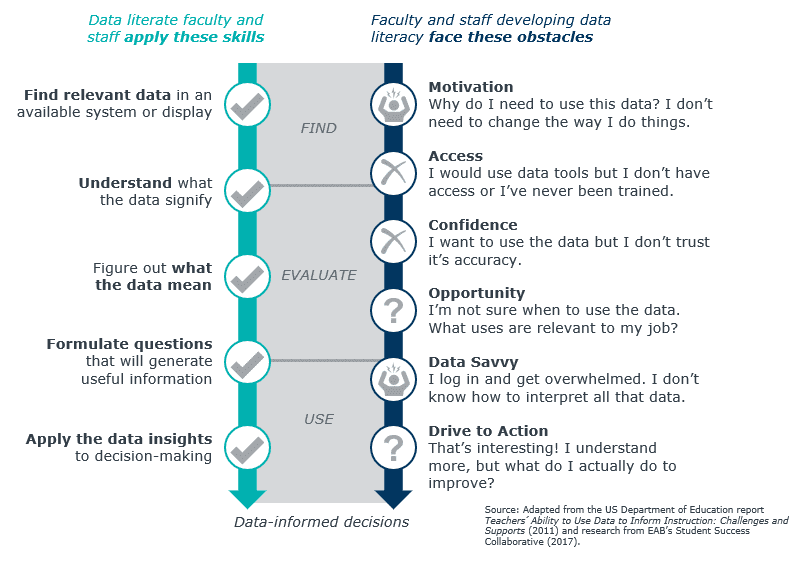3 ways to improve data literacy on campus
In 2018, we wrote about data literacy as the workforce skill every college graduate would need in 2019. Now that data is omnipresent, most jobs require some level of interpretation and analysis. To do this effectively, you must be data literate. Gartner even likens the importance of data literacy to that of actual literacy, noting data’s ubiquity “requires creators and consumers to ‘speak data’ as a common language.”
What is Data Literacy?
Data literacy is defined as the ability to read, write, and communicate data in context, including an understanding of data sources and constructs, analytical methods and techniques applied—and the ability to describe the use case, application, and resulting value. (Gartner, 2019)
Today, we understand that faculty and administrators also need to be data literate. Colleges are producing more data than ever before, and the number of people on campus using analytics tools is growing rapidly. But data literacy is about more than understanding and “speaking” data.
The data literacy spectrum
Instead of viewing data literacy as a skill you either have or don’t, some experts view it as a spectrum or maturity curve of component skills that span finding, evaluating, and using data. These skills build on one another: before you can make a data-informed decision, you need to be able to access data and discern its quality.

Just as the skills build on one another, so can obstacles. For example, some EAB partners report that the motivation to use data in the first place as a common obstacle: this is the “why do we need to change?” mentality that may be all too familiar among some faculty members. Without motivation, any data initiatives will fall at the first hurdle. And even if a staff or faculty member is motivated to work with data and confident in its accuracy, they may not recognize the opportunity without common use cases that are relevant to their job.
Shifting focus from data access to data action
In 2017, when we first polled EAB partners about which of the obstacles listed above presented the biggest challenge to their institution achieving data-enabled decision-making, most named “access” as their primary barrier. Three years later, while access remains a challenge for many, the number of people naming “drive to action” as their top obstacle is rising.

This shift could be due to universities’ continued investment in data and analytics tools. Wider access to these tools makes it easier for faculty and staff to find data when they need it and discover insights that can transform their work. For example, EAB’s Academic Performance Solutions (APS) helps deans and department chairs access data to inform academic program review and instructional capacity decisions, and the APS partnership has continued to grow in the last two years.
Solutions across the data literacy spectrum
As campus leaders expand access to data for decision making, they must find ways to overcome obstacles at all stages of the data literacy spectrum. Here are some of the practices EAB partners are implementing to build and improve data literacy:
To Better Find Data
Create and share a data dictionary
Establish definitions for common data points. EAB research found that successful and user-friendly data dictionaries use clear language and thoughtfully group similar or related terms.
A shared data dictionary can also identify the types of data found in different campus data tools and their primary use cases. Distribute these resources widely to increase transparency and understanding, and audit them regularly to ensure they remain up to date.
To Better Evaluate Data
Empower your Institutional Research (IR) team to champion data literacy
Engage IR staff to offer structured trainings on data tools. One APS partner designed different sessions according to faculty or staff roles so training could focus on specific and relevant use cases.
Other universities ask IR staff to hold guided meetings with deans to understand how they want to use data tools, then use common topics from these meetings to inform user trainings. Supplement official trainings with “lunch and learn” sessions where data users can bring their specific questions and concerns for discussion with IR staff.
To Better Use Data
Build data use requirements into established processes
Some university leaders successfully guide department-level data users to action by providing more prescriptive tools and best practices. For example, some partners require department leaders to base their faculty line requests on demonstrated need. To do this, they built guides to their campus data tools, explaining exactly where users can find the required data on course enrollments and instructional capacity.
Data creation within and beyond higher education doesn’t show any signs of slowing down. In the face of intense demographic and economic pressures, institutions are turning to this wealth of data to guide an increasing number of campus decisions. And this makes building data literacy—the ability to successfully find, evaluate, and use data—more critical than ever before.

More Blogs

How higher ed leaders are diagnosing—and fixing—administrative gaps

4 higher ed alternative revenue ideas that won’t deliver—and what actually will
